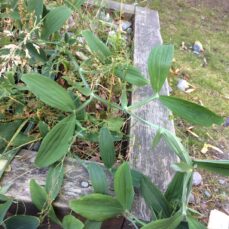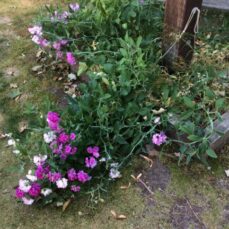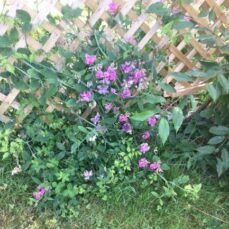
Troy Evans, Great Smoky Mountains National Park, Bugwood.org

Management Category
Squamish
Whistler
Pemberton
Vectors of Spread
Synonyms
- Everlasting peavine
- Everlasting pea
- Perennial peavine
ID Characteristics
General: Broad-leaved peavine is a trailing or climbing perennial.
Flowers: Are pea-like, in shades of white, pink, or red. Flowers form in clusters of 5 – 15 and are unscented.
Stem: Hairless with broad wings; stems can grow between 1 – 2 m long. Stems climb by using tendrils (if there is support) or form a dense mat of vegetation near the ground.
Leaves: Are blue-green and oval-shaped. Leaves grow in pairs with branched tendrils between leaves. Each leaf is smooth and about 7 cm long and 2.5 cm across.
Roots: Broad-leaved peavine has deeply-rooted rhizomes.
Fruits and Seeds: Seeds are found within pea-like pods, which are 7 – 9 cm long. Each seed pod contains 10-25 seeds. These pods are first green and then turn black or dark grey as they mature and dry. Seeds are small, hard, and round.
Similar Species
Invasive

Flat pea (Lathyrus sylvestris): This invasive is from the same family as broad-leaved peavine; the two species are often confused for one another. Flat pea can grow as tall as broad-leaved peavine, but its pods and leaves are smaller.
You can learn more about the similarities and differences between broad-leaved peavine and flat pea in this comparison factsheet.
Habitat and Origin
Origin: Native to the Mediterranean (northern Africa and southern Europe), broad-leaved peavine was originally brought to North America as a garden ornamental for its showy flowers. It was also introduced as a means of erosion control.
Habitat: Typically found growing along roadsides or in disturbed areas where it can outcompete other species. Broad-leaved peavine requires partial or full sun to grow and prefers relatively dry soils.
How it Spreads
Broad-leaved peavine reproduces mainly by rhizomes, with its horizontal roots forming buds and growing new plants. It dies back during the winter and re-grows from deep roots in the spring.
Broad-leaved peavine can also reproduce by seed. When mature, seed pods dry and twist to launch seeds up to 9 m away.
This plant is also sometimes planted as a garden ornamental, or can be present in seed mixes, which aid in its spread.
Impacts
Health:
- Fruits and leaves contain toxic compounds, and if eaten in large quantities these compounds can cause lathyrism, a serious disease. Humans, horses, and other animals with a single stomach are more susceptible.
Ecological:
- Grows to form dense patches that outcompete all over low-growing native vegetation.
- Vines climb up and choke trees and shrubs.
Prevent the Spread
Broad-leaved peavine is found in the Sea to Sky region, but with a limited distribution. The goal is to eradicate this species from the region, and to prevent new introductions.
Learn to identify broad-leaved peavine: use the images presented on this profile page to learn how to identify this plant.
What to do if you spot broad-leaved peavine: You can report any sighting by visiting our reporting page.
DO:
- Regularly monitor properties for infestations.
- Ensure soil and gravel are uncontaminated before transport
- Remove plant material from any equipment, vehicles, or clothing used in infested areas and wash equipment and vehicles at designated cleaning sites before leaving these areas.
- Minimize soil disturbances (e.g. use grazing plans that prevent soil exposure from overgrazing), and use seed mixes with dense, early colonization (e.g. alfalfa or barley) to re-vegetate exposed soil and resist invasion.
- Ensure plants (particularly seed pods or root fragments) are bagged or covered to prevent spread during transport to designated disposal sites (e.g. landfill).
DO NOT:
- Don’t unload, park, or store equipment or vehicles in infested areas
- Do not plant broad-leaved peavine, no matter how well-contained the area might seem.
- DO NOT COMPOST!
Control
Mechanical
- Hand-pulling or cutting stems is a temporary control method since plants re-grow from any remaining roots.
- This regrowth can be hindered by covering the site and surrounding ground with woven plastic fabrics or other materials. This covering must be kept on for a minimum of 2 years, and the location monitored. Note: this method may also stop the growth of other nearby plants, which may not be ideal.
Chemical
- Translocated and selective herbicides (for broad-leaved plants), such as triclopyr and dicamba, can be effective on broad-leaved peavine.
- Picloram is also effective, but it is not suitable for wet, coastal soil.
- Treat areas should not be disturbed until the herbicide has had the chance to work (2 – 3 weeks).
- New vegetation must be established following effective chemical treatment.
- We recommend that any herbicide application is carried out by a person holding a valid BC Pesticide Applicator Certificate. Before selecting and applying herbicides, you must review and follow herbicide labels and application rates; municipal, regional, provincial, and federal laws and regulations; species-specific treatment recommendations, and site-specific goals and objectives.
Cultural
Goats have been known to graze on broad-leaved peavine.
Biological
There is currently no biocontrol agent for this plant.
B.C. Distribution
Broad-leaved Peavine Factsheet
Having trouble viewing the factsheet? Don’t worry, all the information is included on this page. You can also contact us with any questions.
Additional Resources
References
- Consortium of Wisconsin Herbaria, Lathyrus latifolius
- Electronic Atlas of the Flora of British Columbia, Lathyrus latifolius
- Jefferson County Noxious Weed Control Board, Best Management Practices for Everlasting Peavine (Lathyrus latifolius) and Flat Pea (Lathyrus sylvestris)
- Jepson Herbarium at UC Berkeley, Lathyrus latifolius
- New York Flora Atlas, Lathyrus latifolius
- Oregon Department of Agriculture Noxious Weed Control Program, Perennial Peavine (Lathyrus latifolius) Factsheet
- Plant Care Today, Perennial Sweet Pea
- University of Michigan Herbarium, Lathyrus latifolius
- US Department of Agriculture Natural Resources Conservation Service, Lathyrus latifolius
- Washington State Noxious Weed Control Board, Perennial Peavine












